|
The Martinshof Story - Page 2
Page |
Previous |
Next ||
1 |
2 |
3 |
4 |
5 |
6 |
7 |
8 |
9 |
10 |
11 |
12 |
13 |
14 |
15 |
16 |
? |
Next -
Previous -
Top -
Page 1 -
Photos -
Michael's Blog -
Jazclass Links
6. Purchasing the land and building Martinshof
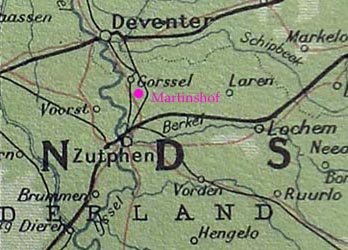 It was probably around 1940 that my Dutch grandmother (Grotie) and my father jointly bough 2 hectares of a small
delightful predominantly pine forest (with a sprinkling of thick tall oaks and elms,
acacias, and even a couple of sweet chestnut trees) located about 5 km to the north of
Zutphen.
It was probably around 1940 that my Dutch grandmother (Grotie) and my father jointly bough 2 hectares of a small
delightful predominantly pine forest (with a sprinkling of thick tall oaks and elms,
acacias, and even a couple of sweet chestnut trees) located about 5 km to the north of
Zutphen.
The purchased land was a NW-SE elongated rectangular block covering the
northwestern corner of the forest.
Our land's northern boundary ran alongside the
Flierderweg, a dirt track divided in two, its main part being a sandy cart and
horse track separated (on its south side) from a narrow bicycle path by wooden poles
placed at regular (50m) intervals.
The Flierderweg formed the boundary between Gorssel (1 km to our north) and
Eefde (2 km to the south, not shown on the above map). This placed us officially
just within Eefde. However both practically and emotionally we always felt part of Gorssel,
where us three children all went to Primary school and had most of our friends.
Opposite us, across the
Flierderweg (and therefore truly in Gorssel) were the grounds and farm of the family van der Meij. Alongside us to our
west was the large nursery Quatre Bras, which separated us from the main
Zutphen-Deventer road (in red on the map), about 300 meters away.
A picturesque tramway
(in black on the map) between Zutphen, Gorssel and Deventer crossed the road at the intersection of
the Flierderweg with the main road. (After the war the track was replaced by a paved bicycle path
which still exists following the identical route of the old tramway.) Diagonally across
from the nursery at the intersection was a bicycle repair shop, later to become Cafe Beuse (and eventually
Restaurant China Town).
 Construction on the house was stared in 1941 and completed in the summer of 1942. While
waiting for its completion we first lived in the Coehoornsingel, then at the end in a
house called De Boompjes ("The Trees") just outside Gorssel.
Construction on the house was stared in 1941 and completed in the summer of 1942. While
waiting for its completion we first lived in the Coehoornsingel, then at the end in a
house called De Boompjes ("The Trees") just outside Gorssel.
The house was designed by the architect Guus Jansen from Zutphen, who later also
designed the very contemporary
display stands used during the Atelier Martinshof years.
Martinshof was built with
second hand bricks derived (I believe) from an old building pulled down in Zutphen at the
time. We had our own water supply, pumped up through a water bore drilled underneath the
house. Electricity was connected, but we had no telephone until several years after the
war. There was some sabotage during construction (notably of gravel being put into some of
the water pipes) because of my parent's political association, but eventually everything
was sorted out to our satisfaction.
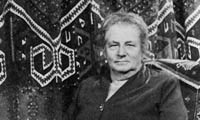 I have no idea how much (if at all) my parents financially contributed to the building of
the house at the time. The fact is that both land and house were officially registered in the name of my
grandmother. This proved to be a stroke of great fortune, for after the war the Dutch
Government confiscated all my parents belongings and assets, but the house remained in our
family's possession. Thanks goodness, because otherwise there might not have been much of a
Martinshof story to tell at all. My father only took possession of our home after my
grandmother's death in 1965.
I have no idea how much (if at all) my parents financially contributed to the building of
the house at the time. The fact is that both land and house were officially registered in the name of my
grandmother. This proved to be a stroke of great fortune, for after the war the Dutch
Government confiscated all my parents belongings and assets, but the house remained in our
family's possession. Thanks goodness, because otherwise there might not have been much of a
Martinshof story to tell at all. My father only took possession of our home after my
grandmother's death in 1965.
Next -
Previous -
Top -
Page 1 -
Photos -
Michael's Blog -
Jazclass Links
7. The naming of Martinshof
The name Martinshof for our house was primarily chosen to commemorate my grandfather Johannes Martinus Furstner, who died in 1935 and, indirectly, was the financial source with which the land was purchased and the house was built. But the emotional bond between the house and the Furstners goes much deeper than that.
Our particular anscestor strain of Furstners has, for many generations, maintained the custom of naming the eldest son of each generation alternately Johannes Martinus or Johannes Theodorus. My father was a Johannes Theodorus, I am, like my grandfather, a Johannes Martinus, and my son is again (like his grandfather) a Johannes Theodorus. The house Martinshof reaches therefore both back in time to our earlier anscestors and forward into the future of our family.
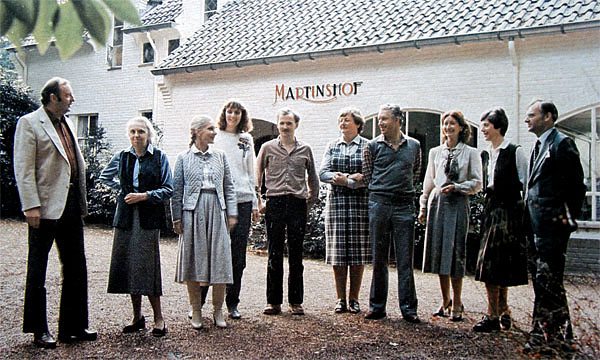 Interestingly (although no doubt unintentionally) the beautiful lettering of the
Martinshof name on the front of the house (designed and hand crafted by the renown
iron smith Jonkers formerly from Gorssel) echoes our alternate naming of
eldest sons through its alternating colours of red and black.
Interestingly (although no doubt unintentionally) the beautiful lettering of the
Martinshof name on the front of the house (designed and hand crafted by the renown
iron smith Jonkers formerly from Gorssel) echoes our alternate naming of
eldest sons through its alternating colours of red and black.
Alternation is movement, is change, and change has been the dominant characteristic
throughout our family's generations. Restlessly we left Austria some 400 years ago, entered
Germany, then gradually moved upwards along the Rhine to eventually cross the Dutch border,
moving through Culemborg, Amsterdam, Rotterdam, The Hague until in 1942 arriving here in
this forest in Eefde.
Martinshof therefore represents a point of rest,
a one generation long comma in the restless history of our family.
But a most important
one, in which one Furstner generation, my parents, unfolded there enormous
creativity and relentlessly driven idealistic dreams. In the process they affected, in
unique and sometimes life changing ways, the lives of most, if not all, who they worked with or
in other ways got involved with them. In this respect it has always been "Martinshof by name, but Jan and Else by nature".
Jan and Else have now both gone. We, their three children, too have made our individual contributions to the
Martinshof Story at the time, but now are continuing our own unique and restless Furstner
trails, all of a creative nature.
My sister Wivica now lives in the Black Forest in Germany, while my
brother Claus (Nicolaus
Martin named after our German grandfather, and the only Martin ever born on Martinshof !! *) and I have long ago migrated to
Australia.
The Martinshof Story however will remain an icon in the
history of jewelry in The Netherlands, and my parents will remain true legends as long as
there are people who remember them.
Note
The only other Furstner born in Martinshof (and in my bedroom there) was my daughter Babette (Else Dorothea Babette Furstner), on January 10, 1964.
Next -
Previous -
Top -
Page 1 -
Photos -
Michael's Blog -
Jazclass Links
8. Arriving at Martinshof 1942
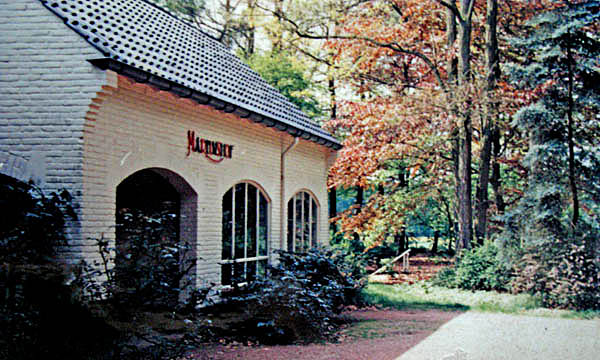 Living at Martinshof was paradise. Perhaps for two reasons.
Living at Martinshof was paradise. Perhaps for two reasons.
Firstly our surname
Furstner is derived from, and actually originally was, Förster, meaning
"forester" in German. Our ancestor were therefore originally closely associated to the
woods. I have felt this very strongly all my life and so have my sister and
brother.
Secondly my mother and us three children had strongly introverted
characters. We live in our minds, away from people, ideally in the tranquility of
nature. My father had a character which sat sort of on the fence, not quite an introvert,
but neither a full on extrovert.
He was therefore ideally suited to form the bridge
between us and the "real world". And of course it was he, who established all the
connections concerning Martinshof, while the rest of us all contributed in creative
artistic ways.
Personally the strongest recollection I have of the first 5 years of my life
(living in Zutphen) is a feeling of great uncomfortable anxiety, feeling totally out of
place. This feeling changed overnight the day we arrived at Martinshof, suddenly I felt at
home, I felt I belonged here. And so did my parents. They must have felt greatly relieved
to escape from the parochial and hostile community of Zutphen. They remained at Martinshof
for the next 40 years.
Next -
Previous -
Top -
Page 1 -
Photos -
Michael's Blog -
Jazclass Links
9. Martinshof : 1942 - 1945
 No sooner had we arrived at Martinshof or my mother's great creative talents started to
unfold. She was very experienced in making the plaited straw art and craft so popular in
Germany and Scandinavia. More often than not we would find the bath tub in the bathroom
half full with cold water with bunches of straw soaking in it.
No sooner had we arrived at Martinshof or my mother's great creative talents started to
unfold. She was very experienced in making the plaited straw art and craft so popular in
Germany and Scandinavia. More often than not we would find the bath tub in the bathroom
half full with cold water with bunches of straw soaking in it.
With Claus
(Nicolaus Martin Furstner) born at Martinshof on March 10, 1942, soon after our arrival
here, my mother was now permanently at home looking after us, while my Dad ran the shop in
the Beukerstraat.
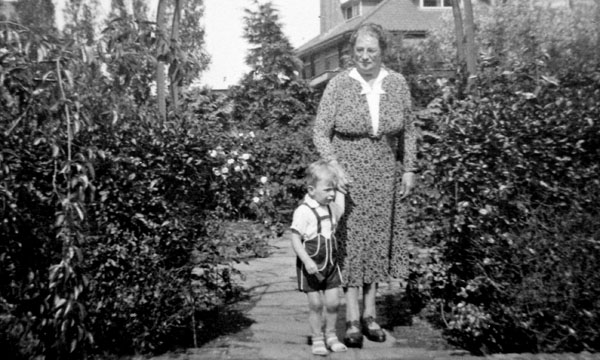 In 1943 or perhaps early 1944, when the Germans feared an invasion by the Allies possibly
landing at the Dutch North Sea coast, civilians living in the coastal areas were evacuated
inland. In this context my Dutch grandmother Grotie arrived at Martinshof from Scheveningen accompanied by her housekeeper Regina and maid
Nel.
In 1943 or perhaps early 1944, when the Germans feared an invasion by the Allies possibly
landing at the Dutch North Sea coast, civilians living in the coastal areas were evacuated
inland. In this context my Dutch grandmother Grotie arrived at Martinshof from Scheveningen accompanied by her housekeeper Regina and maid
Nel.
After the Allied landing in Normandy on June 6, 1944, my father,
anticipating much fighting in Holland, sent my mother and us children to our German
grandparents in Wismar, where
we remained until the end of the war.
My father kept running the shop, but eventually
closed it and, after asking our shop assistant Annie Martinus to look after the
premises, traveled on his bicycle first north to Groningen, then East into Germany and on
to Wismar (a 400 km journey) where he eventually arrived to the great relief of my mother.
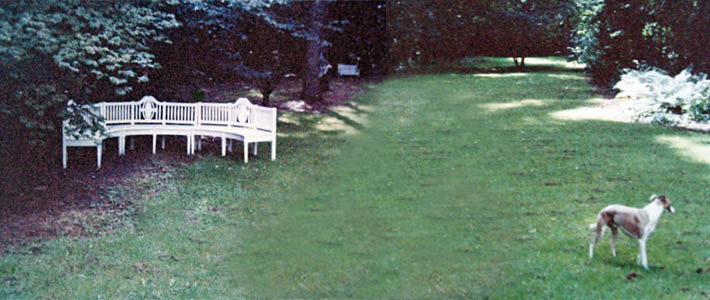 During our year absence there was much coming and going of occupants at Martinshof. First
it were German officers who were billeted there, occupying mainly the lounge and dining
room, then, after their departure in retreat, the Allied officers moved in. Both parties,
after a long night drinking, used to step outside on our terrace and relieve themselves on
the grass, which greatly benefited of this political cross fertilisation, and remained
sparkling green for many years thereafter.
During our year absence there was much coming and going of occupants at Martinshof. First
it were German officers who were billeted there, occupying mainly the lounge and dining
room, then, after their departure in retreat, the Allied officers moved in. Both parties,
after a long night drinking, used to step outside on our terrace and relieve themselves on
the grass, which greatly benefited of this political cross fertilisation, and remained
sparkling green for many years thereafter.
During this period of our absence several civilians also moved into Martinshof. This were
Annie Martinus, a Mrs. Eva Maas of similar age (without her mysterious
husband somewhere at large) and our architect Guus Jansen with his wife and son
Albert. Albert was a typical highly intelligent nerd character, who later as
a brilliant astronomer became the Director of the prestigious Planetarium in The
Hague, when still only in his 20s.
When our family eventually returned from Germany around August 1945 the soldiers had long
since departed, but all the civilians were still there, remaining there for several years
with us after the war.
At our arrival at the Dutch border my father was immediately
arrested and soon after deported to a Dutch concentration camp. My mother was allowed to
travel on and safely deposited us three children back at Martinshof, but after about a week
or so there she too was arrested and placed in a concentration camp (see my story).
Comments -
Next -
Previous -
Top -
Page 1 -
Photos -
Michael's Blog -
Jazclass Links
Copyright © 2009 Michael Furstner
|







